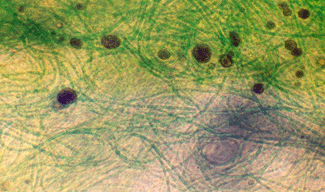Biology

A consortium of bacteria to degrade petrol
The important role that layers of cianobacteria (photosynthetic microorganisms) play in the process of degradation in oil spillages at sea or along the coat is widely known. However recent research undertaken by the Environmental Microbiology Group at the UAB has shown that these cianobacteria, specifically Microcoleus chthonoplastes coming from the Ebro Delta, cannot do this alone but need to create a consortium with three bacteria.
References
Article: Sanchez, O; Diestra, E; Esteve, I; Mas, J. "Molecular Characterization of an Oil-Degrading Cyanobacterial Consortium", MICROBIAL ECOLOGY, eFIRST, Desembre 2005.
After the oil spillages that occurred during the Gulf War in the 90's, several researchers noticed that communities of microorganisms (microbian layers) developed on the coastal sediments contaminated by the oil. These communities were dominated by cianobacteria, photosynthetic microorganisms which played an important role in the degradation of these hydrocarbons.
Various studies using isolations of cianobacteria also showed that these microorganisms were able to break down different petrol fractions. Despite this, it was not clear whether the degradation was carried out exclusively by cianobacteria or by other bacteria which may be associated with them. Some researchers concluded that the bacteria associated with cianobacteria are responsible for degrading hydrocarbons, and that very possibly previous experiments with isolations had not worked with really pure cultures.
Resent research carried out by the Environmental Microbiology Group at the UAB has shown that Microcoleus chthonoplastes isolated from microbacterial layers from the Ebro Delta contaminated with petrol, form a consortium with bacteria that are found in their vicinity. A consortium is a group of microorganisms that benefit from one another mutually and carry out processes that each organism could not do separately. The Microcoleus consortium is able to grow in the presence of oil, degrading various fractions.
The molecular analysis based on the sequencing of RNA ribosomal 16S showed that the consortium was made up of microorganisms which were nitrogen fixers and hydrocarbon degradadors. During the day, Microcoleus provided a protected habitat and a source of oxygen for the associated bacteria. These bacteria used oxygen produced by Microcoleus to oxidize the hydrocarbons, converting them into CO2, which stimulated photosynthesis on the part of the cianobacteria. During the night, the cianobacteria breathe and create an anoxic environment which is necessary for the rest of the bacteria to fix nitrogen.
This research, published in Microbial Ecology, has been carried out by the researchers Olga Sánchez, Elia Diestra, Isabel Esteve and Jordi Mas, belonging to the Environmental Microbiology Group of the Department of Genetics and Microbiology at the UAB.
Olga Sánchez
Department of Genetics and Microbiology
Universitat Autònoma de Barcelona
2024 Universitat Autònoma de Barcelona
B.11870-2012 ISSN: 2014-6388
